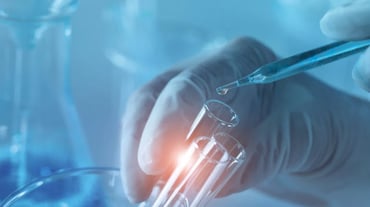January 2020 was unseasonably warm and dry, so pleasant that students on the Anschutz Medical Campus ate lunch at picnic tables and scientists emerged confused and squinting from hibernation in the campus research buildings. One person who was not there was Deguang Kong, visiting graduate student in the lab of Heide Ford, PhD, University of Colorado (CU) Cancer Center Associate Director for Basic Research. With his PhD work wrapping up, Deguang had taken a quick leave to interview for jobs near his home…in Wuhan, China.
February came and volunteers in hazmat suits were spraying the streets of Wuhan for coronavirus. Deguang never made it back from China. Via teleconference, he taught lab member Connor Hughes how to take over his mouse experiments, and he told his roommate Hengbo Zhou, who was also finishing PhD work in the Ford lab, to get ready to defend his dissertation virtually.
“When Hengbo told me he had to get ready to defend virtually, I said ‘don’t be so melodramatic.’ He said we had to watch it, but I couldn’t imagine everything would be shut down here,” says Ford.
A few weeks later his predictions were right, everything shut down here.
Meanwhile in Boulder
On Thursday, March 12, CU Boulder researcher and CU Cancer Center member Sabrina Spencer, PhD, spent the better part of her undergraduate biochemistry lecture discussing how they would be continuing the class online. After the weekend, students wouldn’t be coming back. At the end of the lecture, her students applauded.
“It was surprisingly emotional,” Spencer says. “They were kind of saying goodbye. It just felt like the end of an era – like our lives would be really different after today.”
But by that point, Spencer had spent a month preparing her lab for remote work. The Spencer lab uses cutting- edge technologies to watch single, live cells go about their business. Much of her lab’s cancer work is computational – they gather terabytes of data with nifty microscopes, but then it takes time to crunch the numbers to see what they found.
“I’ve been worried about this virus since early January,” Spencer says. “Despite being called Chicken Little by family, I started recommending to my lab to do all possible experiments first and save the analysis for later. Telling people to cram in six experiments without analysis isn’t normally how you would do science, but I was worried labs would shut down. Now, at least people in my lab have stockpiled data. However, we’re not going to last on that forever. Maybe another two months?”
Two months was exactly what she needed. In May the labs across campuses started to open back up for research with heightened precautions such as social distancing and mask wearing, but being open is a great step in the right direction for research.
Lost Time
“We’re going to lose time and in cancer, time means lives,” says CU Cancer Center Director, Richard Schulick, MD, MBA. Part of this lost time might be delays in basic research that push back the development of new treatments. But the more immediate effect of COVID-19 is on current patients, especially the enrollment of patients on clinical trials that test promising new therapies.
“The pandemic has pushed down clinical trial enrollment,” says Schulick. “Some of these clinical trials are going to be positive and when enrollment is down, we may be losing the opportunity to help patients.”
As CU Cancer Center Associate Director for Clinical Research, no one knows this better than Christopher Lieu, MD.
“If a clinical trial is not deemed critical to survival, those trials are on pause. But unlike some other areas of medicine, cancer clinical trials may be keeping our patients alive,” Lieu says.
However, cancer patients are almost universally immunocompromised, whether from the disease itself or from treatments like chemotherapy, radiation and surgery. For these patients, catching COVID-19 could very well be fatal and visiting a hospital with an influx of COVID-19 patients is imperfect, to say the least. Still, cancer doesn’t care about a pandemic and patients still need treatment.
“In some cases, the benefits outweigh the risks,” Lieu says. “The idea is striking a balance between not harming someone by withholding care, but also not needlessly increasing exposure.” Some trials even remained open for new enrollment. “To put a new patient on trial, it has to be a very critical situation right now, but those situations exist in cancer,” Lieu says.
“Leadership on our campus is doing a great job weighing the various risks and benefits of how we provide cancer care, and working together to find the right balance,” says Schulick. As for new clinical trials, themselves, “We’re thinking about new trials, but we can’t start them,” he says. “It’s like designing a car but not being able to build it – only a million times more important.”
Cancer Research Insights into COVID-19
Along with Ford, Spencer, and the vast majority of other researchers on campus, Joaquin Espinosa, PhD, shut down his lab in March. He works with the biology of how cells “talk” to each other, primarily focusing on cancers and Down syndrome.
One of the major complications of COVID-19 is the overactive immune system of cytokine storm, a cascade of immune activity that attacks a patient’s body and can become even more dangerous than the virus itself.
“All these years we’ve been exploring immune dysregulation in Down syndrome. It’s like people with Down have a cytokine storm every day,” Espinosa says.
With the revelation that the drug being tested in Espinosa’s clinical trial against Down syndrome- associated alopecia may also short-circuit cytokine storm in COVID-19, it didn’t take long to get permission to re-open his lab. Espinosa’s lab is working with an international consortium of investigators testing this drug class in COVID-19 patients while also studying these drugs in animal models of lethal cytokine storms.
The lab of CU Cancer Center investigator, Jennifer Richer, PhD, is also using the tools of cancer research to explore COVID-19. Much of Richer’s recent cancer research has examined the role of androgen (testosterone) receptors. We think of androgen driving prostate cancer, but Richer’s work shows that in addition to hormones like estrogen and progesterone, androgens can drive breast cancers, particularly those resistant to traditional estrogen-blocking therapies. In a fascinating twist, scientists have shown that the “receptors” cells use to grab androgen also control proteins that help viruses enter lung cells. According to Richer, this dependence of viruses on androgen could partially explain why men, who have much higher levels of testosterone than women, are at higher risk of COVID-19 complications. It could also explain why most pediatric cases happen near the onset of puberty.
“That’s one of the things I’ve been doing – seeing what we know already from our work on how breast cancer spreads to the lung that is applicable to viral infections,” Richer says.
In addition to finishing grants and papers on breast cancer, including a major American Cancer Society Institutional Research Grant renewal that funds many of the Cancer Center’s junior faculty, Richer is partnering with CU infectious disease specialist Mario Santiago, PhD, to further explore this crossover between androgen-driven cancers and viral infection at the basic science level.
One question is how easy it will be to pivot back to cancer research once the pandemic ends, or if funding for cancer research will be permanently reprioritized to study infectious disease.
“COVID research is of immediate importance, but cancer research is still important, too – cancer is not going away,” Richer says.
“It’s like ice,” says Lieu, “a quick freeze and a slow thaw to carefully and safely reopen the hospital services, basic science and clinical research. It’s not easy to restart everything and in some ways getting back up to speed is more complex than the closing. The ramifications of that will be seen much longer than anything else.”
That said, CU researchers also find reasons to be hopeful for science, scientists and most of all our patients.
Silver Linings
“We can rethink things, analyze data every which way to see if it’s telling us things we hadn’t seen before,” says Richer. “Having the time to think about your projects – that downtime can really be valuable. It can give you the headspace to think about something in a new way and reevaluate your approach.”
According to Richer, the time to step back and think may lead to new, creative ideas emerging from the pandemic.
“My lab is getting way more thinking time,” agrees Spencer. “They’re reading all the papers they never had time for when they were focused on experimental work.”
And, “With all this work, I think the public and government really understand how important health care research and discovery is,” says Schulick.
According to Schulick, COVID-19 has also helped doctors and researchers learn new ways of communicating and delivering care that may have benefits long after the pandemic ends.
“Overnight, we’ve learned how to do things remotely. I’m seeing patients from very remote places and it’s almost as good as if they had driven 10 hours, stayed in a hotel, saw me for a short appointment, and then drove back 10 hours,” Schulick says.
On the Other Hand…
“Some people are having more focus time, but there’s also a lot lost,” says Ford. “Now we’re six weeks in and at this point, we’re getting diminishing returns from taking time off to think, and it’s time to get back to doing. People are itching to get back into the lab.”
One of these people is Ford’s graduate student, Jessica Hsu.
“I spent a year optimizing the protocol for the experiment and we had just gotten to the point in March where I was comfortable getting started,” she says. Not only was this experiment the last piece of her PhD project, but it was an important part of the Ford lab’s major grant proposal.
“That’s when the discussion of our lab being shut down came about,” Hsu says. “And then it happened.”
Still, there was a chance they could save the experiment.
“Heide forfeited her own access to the lab to have me give me that space,” Hsu says. As her other ‘essential’ lab member, Ford chose Connor Hughes to continue Deguang’s experiments with mice, which were nearly done and which would take six months or more to restart if paused.
“As much as I want to finish my project, I know we can’t rush back to the labs. We’re all taking the precautions needed to come back as seriously as we took the precautions to shut down,” she says.
Until that happens, Hsu will be stuck with a blank space in her PhD manuscript. In the meantime, Deguang will not be able to return from China. Hengbo successfully defended his PhD virtually. Hughes remained essential long enough to complete Deguang’s mouse experiments. Ford has been arranging socially distanced dog walks with colleagues where they talk about what it will look like to get back to work. Lieu and Schulick continue to take care of cancer patients. Spencer is crossing her fingers that it won’t be long before her team can get back into the lab safely. And Richer and Espinosa are doing what they’ve always done: Science meant to save lives.
Like the rest of our world, cancer research has been forced to adapt, and like everywhere it has been imperfect. But research and researchers are resilient.
“This is definitely a speed bump and we will need significant support to get back up to speed,” Schulick says. “But just as cancer doesn’t stop for a pandemic, researchers and doctors who work with cancer can’t stop for the pandemic, either. We continue moving forward. We are still taking care of patients. We are still making progress. And when all this is over, I think we’ll all see how strong and committed our community is to continuing the fight against cancer.”





